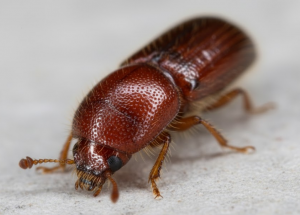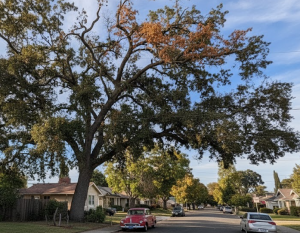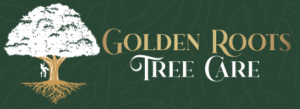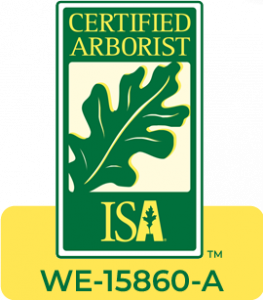In Response to Invasive Beetle Sighting, Golden Tree Care Offers No-Cost Oak Assessments to Sacramento Homeowners
Certified arborists help Sacramento residents identify canopy dieback, the key symptom of the deadly Mediterranean Oak Borer.
SACRAMENTO, CA, UNITED STATES, October 27, 2025 /EINPresswire.com/ -- As Sacramento's iconic "City of Trees" faces a new and insidious threat, Golden Tree Care, a leading local, family-owned tree service, today announced a public service initiative to help homeowners protect their most valuable landscape assets. The company is offering free, no-obligation oak tree consultations for any Sacramento-area resident concerned about the invasive "Oak Killer" beetle, officially known as the Mediterranean Oak Borer.
This tiny, sesame-seed-sized ambrosia beetle has been confirmed in the Sacramento region, including sightings in Citrus Heights and along the American River Parkway. It poses a direct and lethal threat to the area's signature Valley Oaks and Blue Oaks.
Golden Tree Care's initiative aims to combat misinformation and provide homeowners with expert, actionable advice. Certified arborists from the company will personally visit properties to help residents identify the key warning signs of an infestation, primarily the sudden browning of large branches, known as "canopy dieback."
The primary danger of the Mediterranean Oak Borer (MOB) is not the beetle itself, but the deadly fungal pathogen it introduces. The beetle bores into the tree's sapwood to create galleries where it farms a fungus as its sole food source. This fungus clogs the tree's vascular system, cutting off the transport of water and nutrients, effectively starving the tree from the inside out.
"In its native Europe, this beetle is a secondary pest that only attacks dead or dying trees. In California, it is behaving as an aggressive, primary killer, successfully attacking healthy, mature oaks," explains Carlos Sanchez, owner of Golden Tree Care and an ISA Certified Arborist. "The problem is that by the time a homeowner notices the most obvious symptoms, the tree is often deeply infested and may be beyond saving. Early detection is the single most important tool we have to manage this."
Unlike general drought stress, which typically causes a uniform thinning, smaller leaves, or browning at the leaf tips across the entire tree, a MOB infestation is distinct. The key symptom homeowners should look for is "flagging"—one or more large, entire branches in the canopy suddenly wilting and turning brown in late spring or summer, while the rest of the tree appears perfectly healthy.
Other signs of an active infestation include:
• Tiny Boreholes: Pinprick-sized holes (approx. 1-2mm) in the bark, often in cracks or crevices.
• Frass: Fine, powdery sawdust (boring dust) pushed out of the holes, which can sometimes form small, reddish-brown "tubes" on the bark.
• Sap Staining: Dark, wet-looking patches on the bark, though this is less common.
"Our goal with these free consultations is to provide concerned homeowners with peace of mind or a clear plan of action," Carlos Sanchez continued. "We see ourselves as caretakers of Sacramento's urban forest. We don't want residents to panic and remove a healthy, drought-stressed tree, but we also don't want them to ignore a sick tree that could pose a hazard or spread the infestation to its neighbors."
Part of the public service initiative is educating the public on containment. The beetle spreads naturally by flying, but its most rapid, long-distance spread is through the human-assisted movement of infested wood.
"The worst thing someone can do is cut down an infested oak and stack it as firewood, or hire an uncertified service that hauls it away improperly," said Carlos Sanchez. "That infested wood becomes a serious problem, because it will be releasing a new generation of beetles into a new neighborhood. Proper disposal—typically by chipping the wood to a small size on-site or solarizing it under plastic—is critical to breaking the cycle of infestation."
An infested oak can also become a significant safety hazard. The fungal infection and boring galleries structurally compromise the wood, making large branches brittle and prone to sudden failure, even without wind.
Golden Tree Care's free consultations are non-committal and focused purely on identification and education. A certified arborist will conduct a visual inspection, show the homeowner what to look for, and provide a professional assessment of the tree's health and any potential next steps.
Sacramento-area homeowners who are concerned about their oak trees or have noticed sudden browning in their tree's canopy can call 916-707-7100 visit https://goldenrootstree.com to schedule their free consultation.
About Golden Tree Care Founded in Sacramento, Golden Tree Care is a family-owned and operated company dedicated to the health, safety, and beauty of the region's urban canopy. As a fully licensed, bonded, and insured tree service, the company's team of ISA Certified Arborists provides a complete range of professional tree services, including expert pruning, technical tree removals, stump grinding, pest and disease management, and emergency storm response. Golden Tree Care is committed to sustainable practices and providing the highest level of expertise to protect and preserve its clients' valuable trees.
Luis Chavez
Chavez Web Design, LLC
+1 559-553-5000
email us here
Visit us on social media:
Instagram
Facebook
Legal Disclaimer:
EIN Presswire provides this news content "as is" without warranty of any kind. We do not accept any responsibility or liability for the accuracy, content, images, videos, licenses, completeness, legality, or reliability of the information contained in this article. If you have any complaints or copyright issues related to this article, kindly contact the author above.




